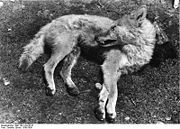Animals of Tibet's Chang Tang
The wildlife on the upper roof of the world.
Tibetan Wolf

The Tibetan wolf (Canis lupus chanco), also known as the Chinese wolf, Mongolian wolf, Korean wolf, Steppes wolf or Woolly wolf is a subspecies of gray wolf found in parts of Central China, southwest Russia, Manchuria, Tibet and the Himalayan regions ofIndia, Nepal and Bhutan. In Tibet, it is known as the Chángú, while near the Niti pass from Kumaon, it is known as the Chankodi.[2]
The Tibetan wolf is thought by some scientists to be the most likely ancestor of the domestic dog, on account of its small size and mandible morphology, noting that the uppermost part of the lower jaw is turned back on both the Tibetan wolf and the dog, though not so in other grey wolf subspecies.[3]
Physically, the Tibetan wolf resembles the common European wolf, but is slightly larger, has shorter legs and has short, pale, fulvous hairs on the ears, flanks and the outside of the legs.[4] The skull is virtually identical to that of the European wolf, though its nose is longer and more slender.[5] It is larger than the Indian Wolf, and lacks a black tail tip.[2] Black wolves in Tibet are known locally as chanko nagpo, and are considered bolder and more aggressive than the pale coloured variety.[6]
The Himalayan Wolf Canis himalayensis was formerly considered to be a subpopulation of the subspecies, but recent studies have proved that it is a separate species.
Wolves can be a serious problem for livestock owners in Tibet. A study on livestock predation showed that the wolf was the most prominent predator, accounting for 60% of the total livestock losses, followed by the snow leopard (38%) and lynx (2%). Goatswere the most frequent victims (32%), followed by sheep (30%), yak (15%), and horses (13%). Wolves killed horses significantly more and goats less than would be expected from their relative abundance.[7]
Before their populations were reduced through hunting, wolves were an occasional threat to human life in Korea. In 1928, wolves claimed more human victims than tigers, leopards, bears and boars combined.[8]
Large numbers of wolves have been reported to reduce leopard populations in Tibet.[9]